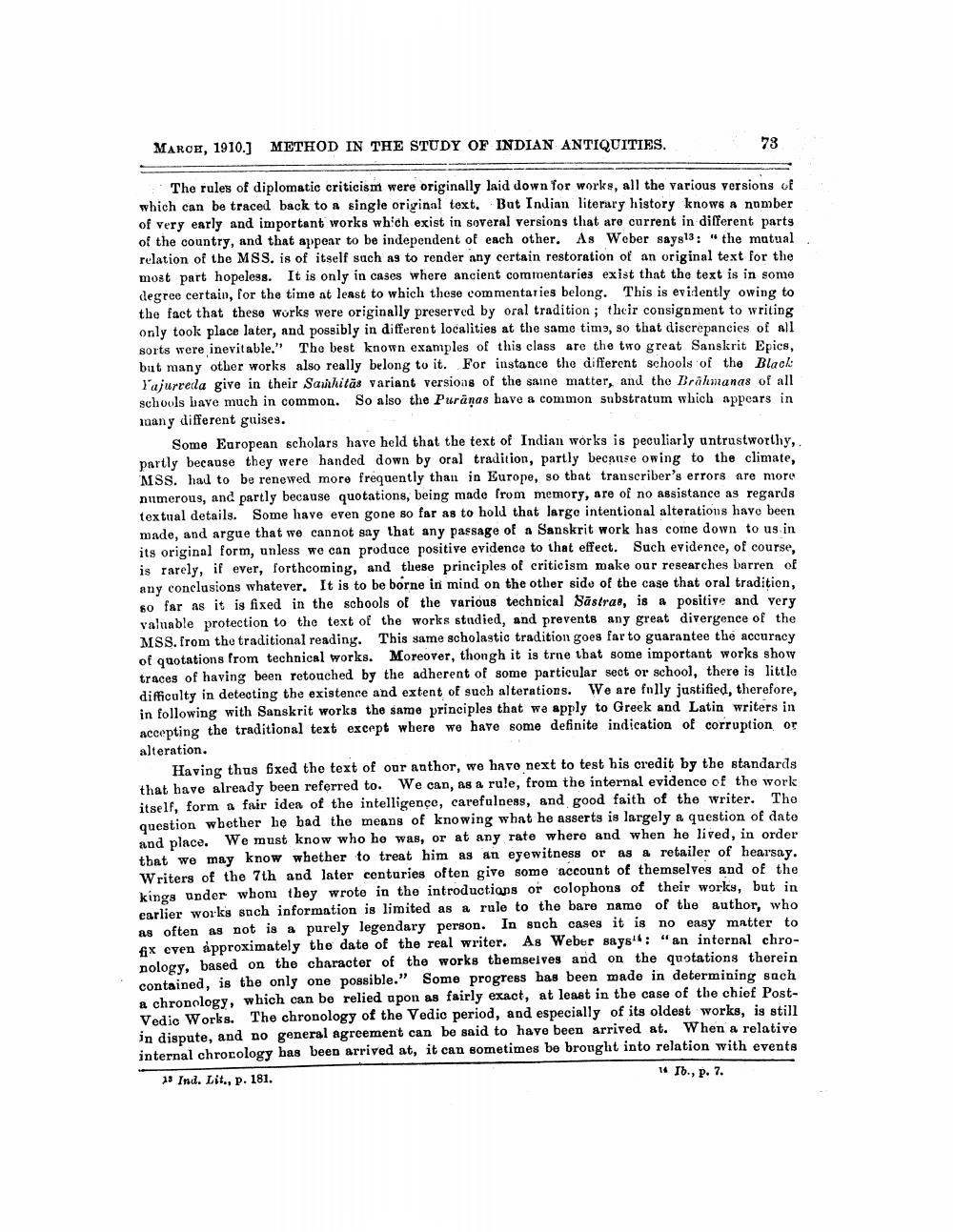________________
73
MARCH, 1910.] METHOD IN THE STUDY OF INDIAN ANTIQUITIES.
The rules of diplomatic criticism were originally laid down for works, all the various versions of which can be traced back to a single original text. But Indian literary history knows a number of very early and important works which exist in soveral versions that are current in different parts of the country, and that appear to be independent of each other. As Weber says13; "the mutual relation of the MSS. is of itself such as to render any certain restoration of an original text for the most part hopeless. It is only in cases where ancient commentaries exist that the text is in some degree certain, for the time at least to which these commentaries belong. This is evidently owing to the fact that these works were originally preserved by oral tradition; their consignment to writing only took place later, and possibly in different localities at the same time, so that discrepancies of all sorts were inevitable." The best known examples of this class are the two great Sanskrit Epics, but many other works also really belong to it. For instance the different schools of the Black Yajurveda give in their Samhitas variant versions of the same matter, and the Brahmanas of all schools have much in common. So also the Puranas have a common substratum which appears in many different guises.
Some European scholars have held that the text of Indian works is peculiarly untrustworthy,. partly because they were handed down by oral tradition, partly because owing to the climate, MSS. had to be renewed more frequently than in Europe, so that transcriber's errors are more numerous, and partly because quotations, being made from memory, are of no assistance as regards textual details. Some have even gone so far as to hold that large intentional alterations have been made, and argue that we cannot say that any passage of a Sanskrit work has come down to us in its original form, unless we can produce positive evidence to that effect. Such evidence, of course, is rarely, if ever, forthcoming, and these principles of criticism make our researches barren of any conclusions whatever. It is to be borne in mind on the other side of the case that oral tradition, so far as it is fixed in the schools of the various technical Sastras, is a positive and very valuable protection to the text of the works studied, and prevents any great divergence of the MSS. from the traditional reading. This same scholastic tradition goes far to guarantee the accuracy of quotations from technical works. Moreover, though it is true that some important works show traces of having been retouched by the adherent of some particular sect or school, there is little difficulty in detecting the existence and extent of such alterations. We are fully justified, therefore, in following with Sanskrit works the same principles that we apply to Greek and Latin writers in accepting the traditional text except where we have some definite indication of corruption or alteration.
Having thus fixed the text of our author, we have next to test his credit by the standards that have already been referred to. We can, as a rule, from the internal evidence of the work itself, form a fair idea of the intelligence, carefulness, and good faith of the writer. The question whether he had the means of knowing what he asserts is largely a question of date and place. We must know who he was, or at any rate where and when he lived, in order as a retailer of hearsay. that we may know whether to treat him as an eyewitness or Writers of the 7th and later centuries often give some account of themselves and of the kings under whom they wrote in the introductions or colophons of their works, but in earlier works such information is limited as a rule to the bare name of the author, who as often as not is a purely legendary person. In such cases it is no easy matter to fix even approximately the date of the real writer. As Weber says: "an internal chronology, based on the character of the works themselves and on the quotations therein contained, is the only one possible." Some progress has been made in determining sach a chronology, which can be relied upon as fairly exact, at least in the case of the chief PostVedic Works. The chronology of the Vedic period, and especially of its oldest works, is still in dispute, and no general agreement can be said to have been arrived at. When a relative internal chronology has been arrived at, it can sometimes be brought into relation with events 14 Ib., p. 7. 13 Ind. Lit., p. 181.




